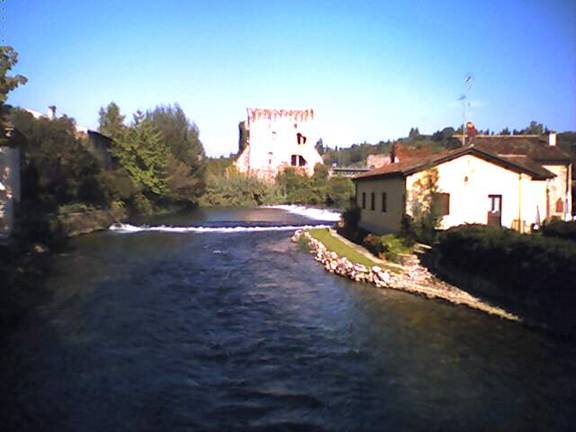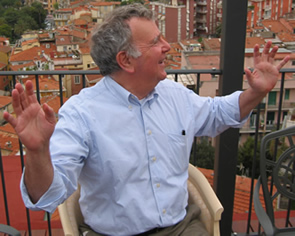Day 17: Mantova
The weather today starts out sunny and clear with a slight nip in the air. After breakfast and a stop at the wi-fi café, we drive to the Palazzo Te, built as a summer palace on the far end of town. We find a parking space on the same street where we had parked on our previous trip. There is a big art show being held there which is advertised heavily all over Mantova….Natura e Maniera: Le Ceneri violette di Giorgione tra Tiziano e Caravaggio. (If any Italian speakers or art experts can help translate “ceneri violette”—other than violet ashes, we would be very grateful.) It is a survey of Northern Italian art from 1500 to 1600 and includes several of the works of Giuliano Romano in the Palazzo Te.
Due to the fact that there is no audioguide or explanations in English, it is a little difficult for us to make too much sense of the theme. And since everyone in Mantova seems to have decided to attend the show on this Sunday morning, it is very difficult for us to see the pictures since we are constantly jockeying for position. We move through the show pretty quickly…there are, of course, some wonderful painters represented—Titian, Tintoretto, Lotto (some wonderful portraits), Coreggio, etc.—but unfortunately much of the context is lost on us. After we finish the show, we make a fast trip through the Palace…we had been here on our first trip and actually heard a chamber music concert in the Palazzo then.
The palace is quite grand—it was designed by Gonzaga favorite Giuliano Romano—with expansive rooms and interesting sculptures. One room—the Room of the Giants—is frescoed on all the walls and the ceiling with a scene of the gods sitting up in Olympus while the giants on earth are being destroyed. The colors are bright and the giants are gigantic…it looks almost like a comic strip illustration showing the giants being crushed by falling boulders and columns. It is definitely unlike any other frescoed room we have ever seen……
We plan to have lunch out of town today. The countryside around Mantova is not the most beautiful in Italy….very flat with a lot of commercial development outside the towns—probably a sign of the area’s prosperity. As we drive further north (toward Lake Garda) and cross into the Veneto region, some hills appear, the countryside becomes prettier, and we can see small hill towns and castles in the distance. The road signs have the names of famous Italian military battles…Solferino, Marengo, etc.
At Vallegio sul Mincio, the river is crossed by an old medieval bridge and the town’s castle dominates the top of the hill. Beneath the bridge and set right on the river, there is a small village called Il Borghetto. Obviously developed to draw Sunday afternoon visitors, it is a picture postcard little cluster of shops and restaurants set on the banks of (and in the middle) of the river. With the warm sunshine, the blue sky, the clear flowing river, the tree lined banks, the small waterfall and the medieval bridge, it is pretty irresistible. We have a leisurely light lunch (some bruschetta to share, a plate of cheese for Diana and stew of horsemeat with polenta for me) and some wine at one of the outdoor restaurants--Divinosteria. For a better description of a Sunday afternoon meal in Il Borghetto, read H.V. Morton’s “A Traveller in Italy”. This elegant book, written in the 1950s, is a great companion to take to Italy…Morton’s love of Italy and his graceful erudition about history and art are wonderful. He had stopped at a trattoria on the riverbank during his trip in the 1950s and describes the buildings, the bridge and the fishermen in the river…it was not too different from our experience—but better written.
After lunch, we stroll through the village on the other side of the river (it is a real town with houses and a couple of hotels and bars) and enjoy the spectacular day. We quickly drive around the town of Vallegio sul Mincio on top of the hill and then head for Isola della Scala….a town south of Verona which is noted for its rice production.
On our first trip to Mantova, we had had one of our most memorable meals at the Riseria Antica Ferron….and we are going back to see if we can buy some more rice (they grow varieties used in risottos—Vialone Nano and Canaroli) and perhaps make reservations for a meal there. The countryside returns to being very flat…lots of big farms and industrial development. And the 17th century Riseria is still there. People are finishing their Sunday afternoon dinner in the restaurant and there is a big reception in a tent set up on the grounds. Diana talks to the chef who tells her that they are closed until Tuesday and that the store that sells the rice is also closed. They have opened a big facility in the town of Isola della Scala with another restaurant, warehouse and a shop but that is also closed until Tuesday. We will have to come back on our next trip to the area.
Back in Mantova, the town is still crowded with Sunday afternoon visitors. After resting at the hotel and making a quick trip to the wi-fi bar, we decide to eat in one of the close by restaurants on the Piazza delle Erbe—Osteria Pavesi. It is not one of our most successful meals…not bad, but just sort of ordinary—maybe we were tired out from the day’s activities. We share the local risotto alla Mantovana again and this rendition is more like traditional risotto, creamy and more liquid….but it is just okay. Diana tries the luccio (local pike) with polenta but it is not as tasty as the luccio that I had at the place next door. My stinco di maiale (roast pork shank)—a gigantic portion—is the best dish…savory and tasty. We drink a Refosco from Friuli, which is very enjoyable.
We skip dessert, walk around the piazza for a few minutes and go back to the hotel.
Some pictures from Vallegio sul Mincio….


Due to the fact that there is no audioguide or explanations in English, it is a little difficult for us to make too much sense of the theme. And since everyone in Mantova seems to have decided to attend the show on this Sunday morning, it is very difficult for us to see the pictures since we are constantly jockeying for position. We move through the show pretty quickly…there are, of course, some wonderful painters represented—Titian, Tintoretto, Lotto (some wonderful portraits), Coreggio, etc.—but unfortunately much of the context is lost on us. After we finish the show, we make a fast trip through the Palace…we had been here on our first trip and actually heard a chamber music concert in the Palazzo then.
The palace is quite grand—it was designed by Gonzaga favorite Giuliano Romano—with expansive rooms and interesting sculptures. One room—the Room of the Giants—is frescoed on all the walls and the ceiling with a scene of the gods sitting up in Olympus while the giants on earth are being destroyed. The colors are bright and the giants are gigantic…it looks almost like a comic strip illustration showing the giants being crushed by falling boulders and columns. It is definitely unlike any other frescoed room we have ever seen……
We plan to have lunch out of town today. The countryside around Mantova is not the most beautiful in Italy….very flat with a lot of commercial development outside the towns—probably a sign of the area’s prosperity. As we drive further north (toward Lake Garda) and cross into the Veneto region, some hills appear, the countryside becomes prettier, and we can see small hill towns and castles in the distance. The road signs have the names of famous Italian military battles…Solferino, Marengo, etc.
At Vallegio sul Mincio, the river is crossed by an old medieval bridge and the town’s castle dominates the top of the hill. Beneath the bridge and set right on the river, there is a small village called Il Borghetto. Obviously developed to draw Sunday afternoon visitors, it is a picture postcard little cluster of shops and restaurants set on the banks of (and in the middle) of the river. With the warm sunshine, the blue sky, the clear flowing river, the tree lined banks, the small waterfall and the medieval bridge, it is pretty irresistible. We have a leisurely light lunch (some bruschetta to share, a plate of cheese for Diana and stew of horsemeat with polenta for me) and some wine at one of the outdoor restaurants--Divinosteria. For a better description of a Sunday afternoon meal in Il Borghetto, read H.V. Morton’s “A Traveller in Italy”. This elegant book, written in the 1950s, is a great companion to take to Italy…Morton’s love of Italy and his graceful erudition about history and art are wonderful. He had stopped at a trattoria on the riverbank during his trip in the 1950s and describes the buildings, the bridge and the fishermen in the river…it was not too different from our experience—but better written.
After lunch, we stroll through the village on the other side of the river (it is a real town with houses and a couple of hotels and bars) and enjoy the spectacular day. We quickly drive around the town of Vallegio sul Mincio on top of the hill and then head for Isola della Scala….a town south of Verona which is noted for its rice production.
On our first trip to Mantova, we had had one of our most memorable meals at the Riseria Antica Ferron….and we are going back to see if we can buy some more rice (they grow varieties used in risottos—Vialone Nano and Canaroli) and perhaps make reservations for a meal there. The countryside returns to being very flat…lots of big farms and industrial development. And the 17th century Riseria is still there. People are finishing their Sunday afternoon dinner in the restaurant and there is a big reception in a tent set up on the grounds. Diana talks to the chef who tells her that they are closed until Tuesday and that the store that sells the rice is also closed. They have opened a big facility in the town of Isola della Scala with another restaurant, warehouse and a shop but that is also closed until Tuesday. We will have to come back on our next trip to the area.
Back in Mantova, the town is still crowded with Sunday afternoon visitors. After resting at the hotel and making a quick trip to the wi-fi bar, we decide to eat in one of the close by restaurants on the Piazza delle Erbe—Osteria Pavesi. It is not one of our most successful meals…not bad, but just sort of ordinary—maybe we were tired out from the day’s activities. We share the local risotto alla Mantovana again and this rendition is more like traditional risotto, creamy and more liquid….but it is just okay. Diana tries the luccio (local pike) with polenta but it is not as tasty as the luccio that I had at the place next door. My stinco di maiale (roast pork shank)—a gigantic portion—is the best dish…savory and tasty. We drink a Refosco from Friuli, which is very enjoyable.
We skip dessert, walk around the piazza for a few minutes and go back to the hotel.
Some pictures from Vallegio sul Mincio….




0 Comments:
Post a Comment
<< Home